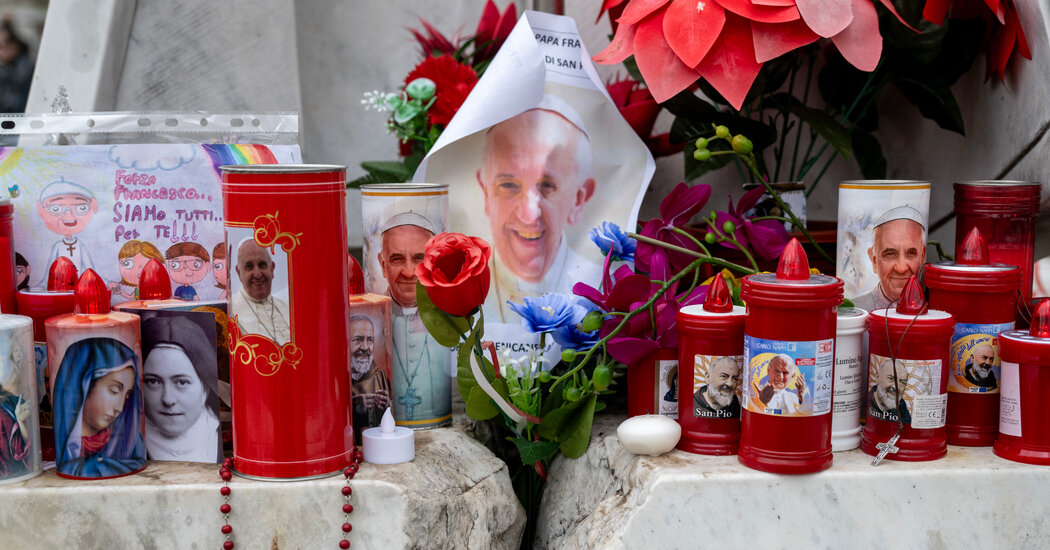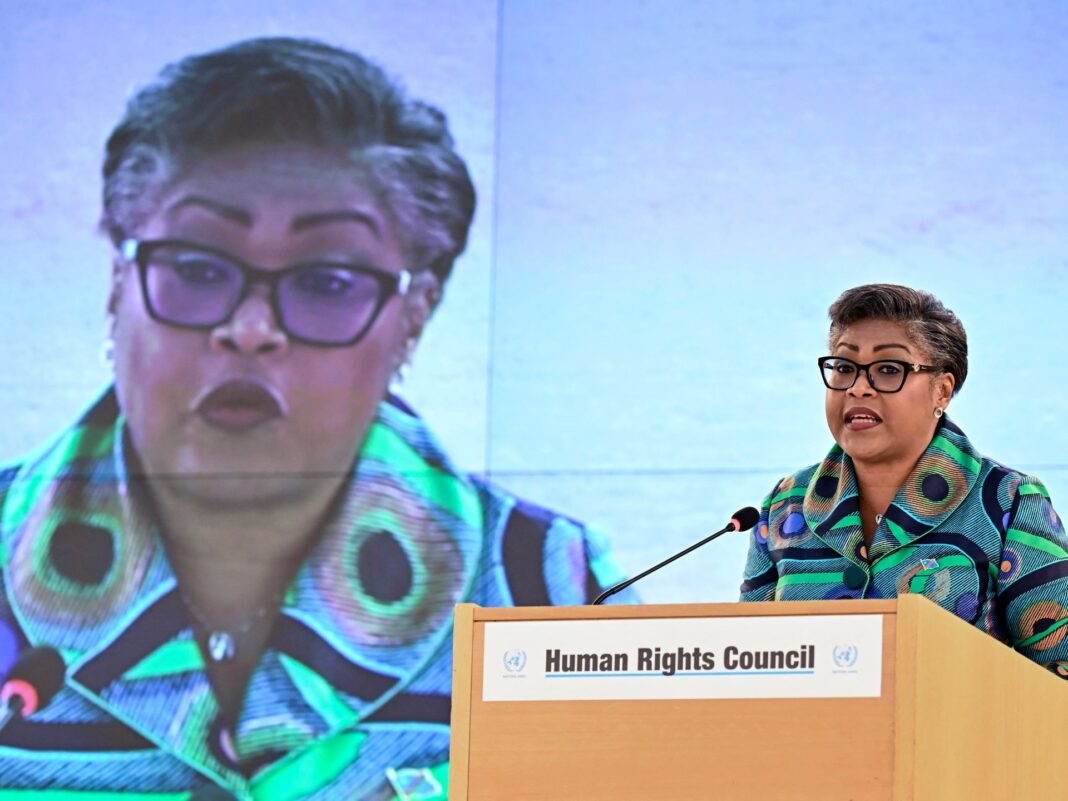The Catholic world is gripped with uncertainty as Pope Francis, 88, remains in critical condition in a Rome hospital because of a complex lung infection and other serious ailments.
On Monday, the Vatican said Francis had awakened from a restful sleep and was responding to therapy. It said that cardinals would gather in front of St. Peter’s on Monday evening to lead a rosary for him.
Here’s what we know about his condition, and about how things would go should he die.
Francis’ condition
Francis’ initial respiratory tract infection has developed into pneumonia in both lungs, and other complications have emerged during his hospital stay. He had a respiratory crisis that has resulted in his having to receive high flows of supplemental oxygen. On Sunday, the Vatican announced that he was suffering from “initial, mild kidney failure,” which was “under control.” He is being treated with various drugs, and his doctors have said that calibrating them has been a challenge. A new medical update will be issued on Monday evening.
Given his age and history of lung disease, doctors have been guarded about his prognosis.
Upon death
While Francis’ fate is still unclear, what is more certain are the time-honored rituals that were drafted and refined over the centuries to ensure secrecy and an orderly transition. The carefully choreographed pageantry provides order to a church in its most dramatic moment of flux.
A pope’s death is immediately confirmed by the head of the Vatican’s health department and the cardinal chamberlain of the Holy Roman Church, who becomes the Vatican’s de facto administrator. The pope’s body is dressed in a white cassock and brought to the pope’s private chapel.
The cardinal chamberlain, camerlengo in Italian, is a position now held by Cardinal Kevin Joseph Farrell, a 77-year-old American of Irish origin. He and other officials, along with members of the pope’s family, congregate in the chapel for a ceremony. The body is placed in a coffin made of wood and lined with zinc. The pope is dressed in red, his miter and pallium placed next to him.
After the ceremony, the camerlengo drafts a document authenticating the pope’s death, affixing the doctor’s report. He secures the pontiff’s private papers and seals his apartments, which in the case of Francis are a large section of the second floor at the Casa Santa Marta, the Vatican City guesthouse used by visiting cardinals, where Francis has lived throughout his papacy.
He also arranges for the destruction of the so-called fisherman’s ring, used by the pope to seal documents, with a ceremonial hammer, to prevent forgeries.
Paying respects
Francis has brought an unpretentious style to the church — rejecting elaborate outfits and the ornate papal apartments. His plans keep that up to the end, scaling back some of the funerary pomp and circumstance.
In rewriting the funeral rites in 2024, Francis simplified several elements. Since the 13th century, the bodies of popes have gone on public view, their embalmed bodies placed on a raised pedestal. When John Paul II died in 2005, his body was first brought to the Apostolic Palace within hours for a private viewing for cardinals, bishops and other members of the church hierarchy, as well as prominent Italian officials.
Francis has done away with that sort of viewing. Instead, a public viewing will take place directly in St. Peter’s Basilica, where thousands have thronged to pay respects to popes in the past. But his body will remain in the coffin, which will not be on a raised pedestal. “Francis decided to highlight humility over glorification,” said Agostino Paravicini Bagliani, a church historian.
The College of Cardinals decides on the day and hour that the pope’s body will be brought to St. Peter’s Basilica, in a procession led by the camerlengo, and on when the viewing will commence.
The funeral
The funeral and burial of the pope must take place between four and six days after his death, and funeral rites in various churches in Rome will last nine days.
Past popes were put in three nested coffins, one of cypress, one of zinc and one of elm. But as part of Francis’ rule change, he decreed that he would be buried in a single coffin, made of wood and lined in zinc.
The coffin is closed the night before the funeral. The pope’s face is covered by a white silk veil and he is buried with a bag containing coins minted during his papacy and a canister with a “rogito,” or deed, briefly listing details of his life and papacy. The rogito is read aloud before the coffin is closed.
The new rules also allow for a pope to be buried in a church other than St. Peter’s Basilica. Francis has asked to be buried instead in the Basilica of St. Mary Major, a church dear to him and one he often visited to pray in front of an icon of the Virgin Mary.
The conclave
Within 15 to 20 days of the pope’s death, the dean of the College of Cardinals, Cardinal Giovanni Battista Re, 91, will summon the cardinals to Rome for what is known as a conclave to elect Francis’ successor.
The period between the death of a pope and the election of a new one is called the sede vacante, or “the seat is vacant.” During that time, the College of Cardinals keeps general oversight of the church, but it is barred from making any major decisions.
When the cardinals meet, they gather in the Sistine Chapel. All cardinal electors must swear an oath of secrecy and vote by secret ballot. Only cardinals under age 80 are eligible to vote. A two-thirds majority is needed to elect a new pope, and politicking is part of the process.
Cardinals are not allowed to leave the conclave except in rare cases. The word conclave — from the Latin “with key” — refers to the isolation imposed on them, which is meant keep the electoral process from dragging on.
During the conclave, the cardinals live in Casa Santa Marta, which was built on John Paul II’s orders to replace the improvised rooming arrangements in the papal palace that had previously housed them.
The white smoke
The cardinals cast repeated votes until a two-thirds majority emerges. After every vote, smoke is released through a chimney that can be seen from St. Peter’s Square, where crowds typically form to watch and wait. If a vote ends without a two-thirds majority, the smoke is black.
When a decision is reached, the smoke is white.
Inside the Vatican, the dean of the college asks the chosen successor whether he accepts the job. After getting the presumed yes, the dean asks him for the name he wishes to be called as pope.
In the sacristy of the chapel, the new pontiff is dressed in a white cassock. After greeting the cardinals, he proceeds to a balcony of St. Peter’s Basilica, where a senior cardinal proclaims, in Latin, “Habemus papam” or “We have a pope.”


